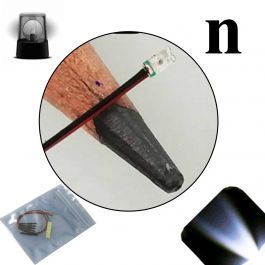MeatySteak
New Member
Hi,
I am very new to circuits, as probably evident by the basicness of this one, and am especially new to LEDs. I bought some LEDs, specs are advertised as 3v, 20mA. So pretty standard. I'll link them down below this. They do come with their own resistors pre-wired, but I wanted to move things around. The pre-wired resistors are 1500ohm metal film, and there is one per resistor as you would expect. I'm using a 12v power supply, and as long as my calculations are correct, that would mean that the LED would receive 6mA of current each, well below the advertised 20mA. This setup does work however, 6mA seems to be enough to power it well enough. I'm assuming 20mA is just the maximum current aloud without it burning out.
So, what I wanted to do was instead of having a resistor for each LED, have only one to control multiple LEDs, specifically one for the blue ones and one for the white ones. I attached a very rough picture of what I plan on doing along with the basic calculations to figure out the resistance for the resistors. Hopefully I have everything right and it makes sense. Just want to confirm whether this will in fact work or if what I have done is just stupid.
In short, I want to connect 4 Blue LEDs to one resistor with a current output of 0.024A (so 0.006 for each LED), and 10 White LEDs to another resistor with an output of 0.1A (so 0.01A for each LED). Reason for this is so I dont have 14 resistors which I would need to try and fit into a very small space but instead only have 2 which is very manageable.
Please be gentle, I am not an artist and I dont work with circuits very often.
Links:
https://lighthouseleds.com/pre-wire...ngle-12v-pre-wired-led-blue-ultra-bright.html

 lighthouseleds.com
lighthouseleds.com
Thanks!

I am very new to circuits, as probably evident by the basicness of this one, and am especially new to LEDs. I bought some LEDs, specs are advertised as 3v, 20mA. So pretty standard. I'll link them down below this. They do come with their own resistors pre-wired, but I wanted to move things around. The pre-wired resistors are 1500ohm metal film, and there is one per resistor as you would expect. I'm using a 12v power supply, and as long as my calculations are correct, that would mean that the LED would receive 6mA of current each, well below the advertised 20mA. This setup does work however, 6mA seems to be enough to power it well enough. I'm assuming 20mA is just the maximum current aloud without it burning out.
So, what I wanted to do was instead of having a resistor for each LED, have only one to control multiple LEDs, specifically one for the blue ones and one for the white ones. I attached a very rough picture of what I plan on doing along with the basic calculations to figure out the resistance for the resistors. Hopefully I have everything right and it makes sense. Just want to confirm whether this will in fact work or if what I have done is just stupid.
In short, I want to connect 4 Blue LEDs to one resistor with a current output of 0.024A (so 0.006 for each LED), and 10 White LEDs to another resistor with an output of 0.1A (so 0.01A for each LED). Reason for this is so I dont have 14 resistors which I would need to try and fit into a very small space but instead only have 2 which is very manageable.
Please be gentle, I am not an artist and I dont work with circuits very often.
Links:
https://lighthouseleds.com/pre-wire...ngle-12v-pre-wired-led-blue-ultra-bright.html

12v 0606 / 0603 Nano 1.5Hz Flashing SMD Wide Angle Pre-Wired Cool / Clear White LED - Ultra Bright - 5 Pack - (10v, 11v, 12v, 13v, 14v, 15v, 16v, 17v, 18v)
The 12v 0606 / 0603 Nano 1.5Hz Flashing smd wide angle cool / clear white pre-wired LED makes it almost the easiest way to add light nearly any project.
Thanks!
Last edited:
